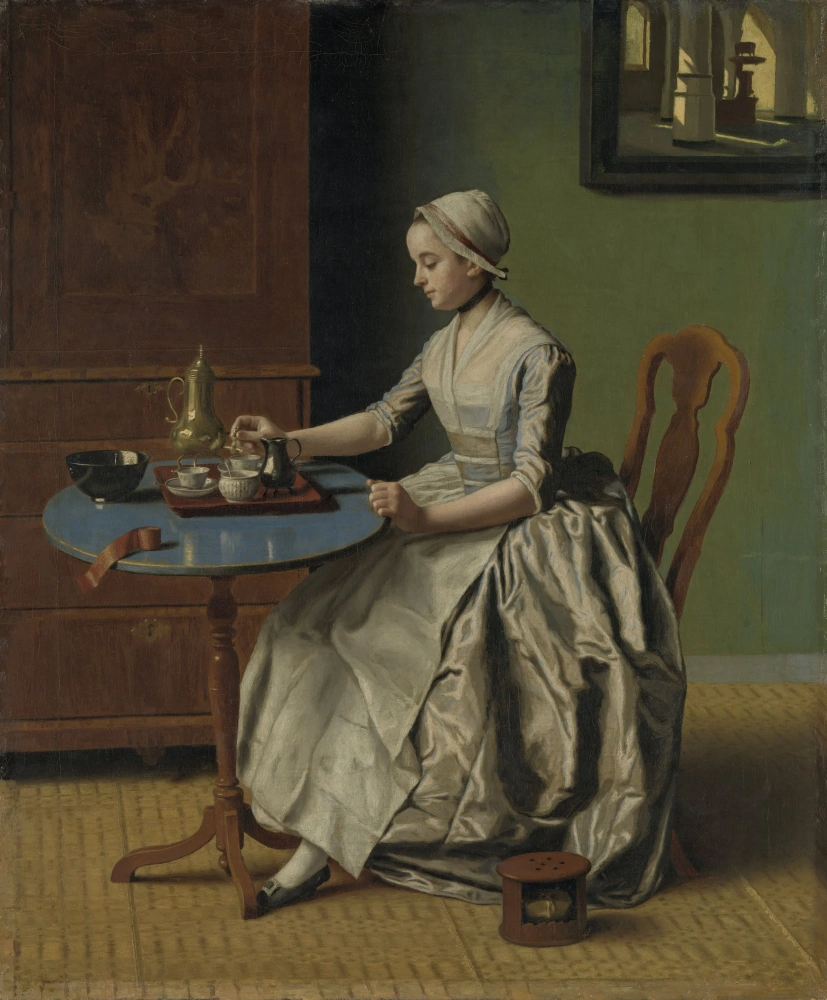войти
Войдите на сайт
Залогиньтесь, чтобы использовать максимум функций Артхива
Голландская девушка за завтраком
Жан-Этьен Лиотар • Живопись, 1757, 46×40 см


















Описание картины «Голландская девушка за завтраком»
«Голландская девушка за завтраком» — это личная ода Жана-Этьена Лиотара Золотому веку нидерландской живописи. Швейцарский художник создал работу в стиле голландских мастеров XVII столетия примерно в 1756 году — во время пребывания в Голландии. Спустя почти 20 лет её приобрёл Уильям Понсонби, 2-й граф Бессборо, большой друг и покровитель живописца. Потомки аристократа передавали картину из поколения в поколение в течение 240 лет. На момент продажи в 2016 году это была единственная жанровая сцена Лиотара, написанная маслом, которая оставалась в частных руках.
Полотно излучает ту же атмосферу умиротворения и спокойствия, что и «Молочница» Яна Вермеера. В скромно обставленном интерьере молодая женщина сидит за маленьким столиком. Она осторожно открывает краник серебряного кофейника над фарфоровой чашкой. Это не служанка, тем не менее, она одета в скромное платье серо-коричневого и голубого цветов и кремовый передник. Волосы девушки скрыты под простым белым чепчиком с коричневой ленточкой.
Пол устлан соломенным ковриком, стену украшает церковный интерьер – голландская картина XVII века. Столешница слегка наклонена так, чтобы художник мог продемонстрировать своё мастерство в передаче его синей полированной поверхности, лакированной плоскости красного подноса, блеска серебра и матовости фарфора.
Лиотара восхищали старые голландцы, такие как Ян ван Хёйсум, Геррит Доу и Герард Терборх, и эта работа, возможно, была задумана как подражание им. Тот факт, что картина написана на холсте, очень необычен для творчества швейцарца, который предпочитал пастель и бумагу. При этом детали интерьера (столик, стул и грелка для ног) соответствуют голландской моде 1740-х – 1750-х годов, а элементы кофейного сервиза (серебряный кофейник на трёх ножках, серебряный кувшин для молока и особенно китайские фарфоровые чашки с блюдцами) появляются во многих известных жанровых сценах Лиотара.
Поскольку нет никаких записей о заказчике этой картины, скорее всего, Лиотар написал её для размышления или же собственного удовольствия. И героиня, и сама тема роднит эту работу с самым известным произведением художника – пастелью «Прекрасная шоколадница». Последняя была написана в Вене примерно в 1744-м – 1745 годах и вскоре после этого продана графу Франческо Альгаротти. Ныне она находится Галерее старых мастеров в Дрездене.
«Голландскую девушку за завтраком» Лиотар пытался продать во время выставки в своей лондонской квартире в 1773 году вместе с другими своими работами и произведениями старых голландцев. Распродажа потерпела неудачу, и в апреле следующего года художник решил отправить картины на аукцион Christie’s. Там «Голландскую женщину, наливающую кофе», как её называл сам автор, и купил уже упомянутый 2-й граф Бессборо. За всю жизнь аристократ собрал свыше 70-ти творений Лиотара. В их число входил и знаменитый «Завтрак» (Le Déjeuner Lavergne), за который ценитель заплатил громадную по тем временам сумму в 200 гиней – самое большое вознаграждение, полученное живописецем за свою карьеру.
Без малого два с половиной столетия «Девушка за завтраком» хранилась в графской семье, пока в 2016 году не была выставлена на аукцион Sotheby’s. Полотно приобрёл амстердамский Рейксмузеум за почти 5,2 млн евро.
Как и в работах великих голландских жанристов XVII века, таких как Габриель Метсю и Ян Вермеер, которыми так восхищался Лиотар, настоящая тема его картины заключается в спокойном созерцании переходов цвета и игры света на различных текстурах, в очень личном взгляде, который выходит за рамки простого жанра.
Автор: Влад Маслов
Полотно излучает ту же атмосферу умиротворения и спокойствия, что и «Молочница» Яна Вермеера. В скромно обставленном интерьере молодая женщина сидит за маленьким столиком. Она осторожно открывает краник серебряного кофейника над фарфоровой чашкой. Это не служанка, тем не менее, она одета в скромное платье серо-коричневого и голубого цветов и кремовый передник. Волосы девушки скрыты под простым белым чепчиком с коричневой ленточкой.
Пол устлан соломенным ковриком, стену украшает церковный интерьер – голландская картина XVII века. Столешница слегка наклонена так, чтобы художник мог продемонстрировать своё мастерство в передаче его синей полированной поверхности, лакированной плоскости красного подноса, блеска серебра и матовости фарфора.
Лиотара восхищали старые голландцы, такие как Ян ван Хёйсум, Геррит Доу и Герард Терборх, и эта работа, возможно, была задумана как подражание им. Тот факт, что картина написана на холсте, очень необычен для творчества швейцарца, который предпочитал пастель и бумагу. При этом детали интерьера (столик, стул и грелка для ног) соответствуют голландской моде 1740-х – 1750-х годов, а элементы кофейного сервиза (серебряный кофейник на трёх ножках, серебряный кувшин для молока и особенно китайские фарфоровые чашки с блюдцами) появляются во многих известных жанровых сценах Лиотара.
Поскольку нет никаких записей о заказчике этой картины, скорее всего, Лиотар написал её для размышления или же собственного удовольствия. И героиня, и сама тема роднит эту работу с самым известным произведением художника – пастелью «Прекрасная шоколадница». Последняя была написана в Вене примерно в 1744-м – 1745 годах и вскоре после этого продана графу Франческо Альгаротти. Ныне она находится Галерее старых мастеров в Дрездене.
«Голландскую девушку за завтраком» Лиотар пытался продать во время выставки в своей лондонской квартире в 1773 году вместе с другими своими работами и произведениями старых голландцев. Распродажа потерпела неудачу, и в апреле следующего года художник решил отправить картины на аукцион Christie’s. Там «Голландскую женщину, наливающую кофе», как её называл сам автор, и купил уже упомянутый 2-й граф Бессборо. За всю жизнь аристократ собрал свыше 70-ти творений Лиотара. В их число входил и знаменитый «Завтрак» (Le Déjeuner Lavergne), за который ценитель заплатил громадную по тем временам сумму в 200 гиней – самое большое вознаграждение, полученное живописецем за свою карьеру.
Без малого два с половиной столетия «Девушка за завтраком» хранилась в графской семье, пока в 2016 году не была выставлена на аукцион Sotheby’s. Полотно приобрёл амстердамский Рейксмузеум за почти 5,2 млн евро.
Как и в работах великих голландских жанристов XVII века, таких как Габриель Метсю и Ян Вермеер, которыми так восхищался Лиотар, настоящая тема его картины заключается в спокойном созерцании переходов цвета и игры света на различных текстурах, в очень личном взгляде, который выходит за рамки простого жанра.
Автор: Влад Маслов



